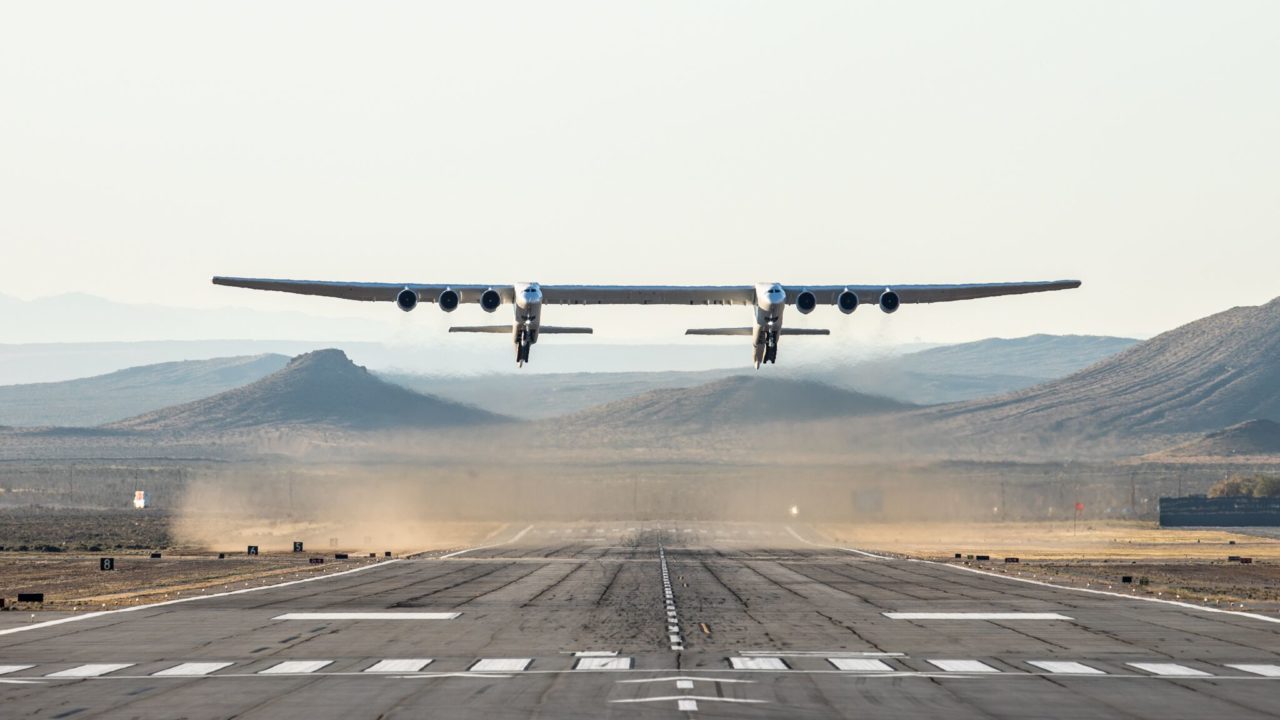
The Stratolaunch landing at Mojave Air and Space Port. (Stratolaunch)
Frankenstein together two Boeing jets by the wing and you get a 250-ton beast with a wingspan of 385 feet and a max weight of 650 tons. That makes Stratolaunch the largest plane in the world, and it first took flight over the weekend, soaring above the Mojave Desert for 2.5 hours.
Stratolaunch Systems, founded by the late billionaire and Microsoft co-founder Paul Allen, is developing the self-titled aircraft as an entree into the commercial space market. The aircraft is intended to hold a space-bound launch vehicle under its center wing — between the two fuselages — that it can launch into orbit from normal flight. After that, Stratolaunch could return to a runway and be loaded for another launch, acting as an airborne launchpad, or mother ship. That would allow space flight from a typical runway for compatible vehicles rather than requiring a rocket launchpad.
The Stratolaunch features six Pratt & Whitney PW4056 engines — three on each outer wing — that can push the twin-fuselage aircraft to an altitude of 35,000 feet.
The April 13 test did not include a rocket payload and flew only to 17,000 feet, but the company said the flight allowed pilots to evaluate performance and handling as the aircraft reached speeds up to 189 mph.

The Stratolaunch features three Pratt & Whitney engines on each side. (Stratolaunch)
“The flight itself was smooth, which is exactly what you want the first flight to be. And for the most part, the airplane flew as predicted which is again exactly what we want,” said Evan Thomas, the Scaled Composites test pilot who flew the Stratolauncher. “We got running down the runway, did our rotation and the airplane very nicely and smoothly rotated. It really just lifted off the ground and definitely was ready to fly and wanted to fly. It climbed out quickly, and that was great to see. Then, we turned out and basically went right into our test cards, climbing up to 15,000 [feet]. For the first part of the flight, we checked out the handling qualities of the aircraft, which again, it flew very much like we had simulated and predicted, which is exactly what we want.”
“We saw a few little things that were off-nominal, but really for a first flight, it was spot on,” Thomas added. “We checked out the handling qualities, they all looked pretty good. Our air data system was really close and that was very nice. We brought down the flaps and then we repeated our handling qualities, taking a look at what it was going to be like to land, checking the pitch response of the airplane, and then practicing some rolls and yaws to make sure we’d be able to line up with the runway like we wanted to. That all felt pretty good. The systems on the airplane ran like a watch. It is a very complex airplane – the propulsion, the pneumatic system, the hydraulics; they all ran perfectly which was great. … I honestly could not have hoped for more on a first flight especially of an airplane of this complexity and this uniqueness.”

The Stratolaunch team wore patches in honor of founder Paul G. Allen, who died last October. (Stratolaunch)
Before landing, pilots conducted a series of simulated approaches, which Thomas said “all felt good,” and allowed the team to gather additional data. Then, they landed the flying catamaran at Mojave Air and Space Port, also the takeoff location.
The Stratolaunch is meant to be used with Northrop Grumman’s Pegasus rocket as well as an in-development launch vehicle and eventual space plane that is being theorized. Stratolaunch Systems has not provided a timeline for further testing or commercial readiness, but invite interested parties to reach out for more information. The company was founded in 2011.